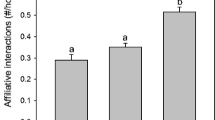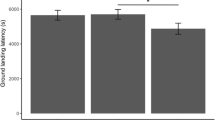Summary
Young from 10 litters of Richardson's ground squirrels were crossfostered within 24 h of birth. Litters, composed then of uterine-sibs and fostered non-sibs, were caged together until 37 days of age (1 week after weaning), at which time the juveniles were separated and caged individually. At a mean age of 110 d squirrels were tested for recognition during 10-min trials in an arena using the following “pair-types”: sibs reared together (SRT), sibs reared apart (SRA), non-sibs reared together (NSRT), and non-sibs reared apart (NSRA). Juvenile S. richardsonii displayed an ability, determined prenatally or soon after birth, to recognize their biological siblings. Familiarity, based upon association before and at the time of weaning, also affected discrimination between conspecifics, although this effect was less apparent.
Similar content being viewed by others
References
Altmann J (1974) Observational study of behaviour: sampling methods. Behaviour 49:227–267
Barash DP (1975) Marmot alarm-calling and the question of altruistic behaviour. Am Midl Nat 94: 468–470
Barash DP, Holmes WG, Greene PJ (1978) Exact versus probabilistic coefficients of relationship: some implications for sociobiology. Am Nat 112:355–363
Bekoff M (1981) Mammalian sibling interactions: genes, facilitative environments, and the coefficient of familiarity. In: Gubernick DJ, Klopfer PH (eds) Parental care in mammals. Plenum, New York, pp 307–346
Betts BJ (1976) Behaviour in a population of Columbian ground squirrels, Spermophilus columbianus columbianus. Anim Behav 24:652–680
Blaustein AR, O'Hara RK (1981) Genetic control for sibling recognition? Nature 290: 246–248
Brown RE (1979) Mammalian social odors: a critical review. Adv Study Behav 10:103–162
Buckle GR, Greenberg L (1981) Nestmate recognition in sweat bees (Lasioglossum zephyrum): does an individual recognize its own odour or only odours of its nestmates?. Anim Behav 29:802–809
Choi SC (1978) Introductory applied statistics in science. Prentice Hall, Englewood Cliffs, New Jersey
Dunford C (1977a) Social system of round-tailed ground squirrels. Anim Behav 25:885–906
Dunford C (1977b) Kin selection for ground squirrel alarm calls. Am Nat 111:782–785
Ferron J (1981) Comparative ontogeny of behaviour in four species of squirrels (Sciuridae). Z Tierpsychol 55:193–216
Finney DJ (1980) Statistics for biologists. Chapman and Hall, London
Grau HJ (1982) Kin recognition in white-footed deermice (Peromyscus leucopus). Anim Behav 30:497–505
Greenberg L (1979) Genetic component of bee odor in kin recognition. Science 206:1095–1097
Hamilton WD (1963) The evolution of altruistic behavior. Am Nat 97:354–356
Hamilton WD (1964) The genetical evolution of social behaviour, I and II. J Theor Biol 7:1–52
Harris MA, Murie JO (1982) Responses to oral gland scents from different males in Columbian ground squirrels. Anim Behav 30:140–148
Holmes WG, Sherman PW (1982) The ontogeny of kin recognition in two species of ground squirrels. Am Zool (in press)
Hoogland JL (1981) Nepotism and cooperative breeding in the black-tailed prairie dog (Sciuridae: Cynomys ludovicianus). In: Alexander RD, Tinkle DW (eds) Natural selection and social behavior: recent research and new theory. Chiron Press, New York, pp 283–310
Maynard Smith J (1964) Group selection and kin selection. Nature 201:1145–1147
McLean IG (1982) The association of female kin in the Arctic ground squirrel. Spermophilus parryii. Behav Ecol Sociobiol 10:91–99
Michener GR (1974) Development of adult-young identification in Richardson's ground squirrel. Dev Psychobiol 7:375–384
Michener GR (1981) Ontogeny of spatial relationships and social behaviour in juvenile Richardson's ground squirrels. Can J Zool 59/1666–1676
Porter RH, Wyrick M (1979) Sibling recognition in spiny mice (Acomys cahirinus): influence of age and isolation. Anim Behav 27:761–766
Porter RH, Tepper VJ, White DM (1981) Experimental influences on the development of huddling preferences and “sibling” recognition in spiny mice. Dev Psychobiol 14:375–382
Sheppard DH, Yoshida SM (1971) Social behavior in captive Richardson's ground squirrels. J Mammal 52:793–799
Sherman PW (1977) Nepotism and the evolution of alarm calls. Science 197:1246–1253
Sherman PW (1980) The limits of ground squirrel nepotism. In: Barlow GW, Silverberg J (eds) Sociobiology: beyond nature/nurture. Westview Press, Colorado, pp 505–544
Sherman PW (1981) Reproductive competition and infanticide in Belding's ground squirrels and other animals. In: Alexander RD, Tinkle DW (eds) Natural selection and social behavior: recent research and new theory. Chiron Press, New York, pp 311–331
Wu HMH, Holmes WG, Medina SR, Sackett GP (1980) Kin preference in infant Macaca nemestrina. Nature 285:225–227
Author information
Authors and Affiliations
Rights and permissions
About this article
Cite this article
Davis, L.S. Sibling recognition in Richardson's ground squirrels (Spermophilus richardsonii). Behav Ecol Sociobiol 11, 65–70 (1982). https://doi.org/10.1007/BF00297668
Received:
Accepted:
Issue Date:
DOI: https://doi.org/10.1007/BF00297668




